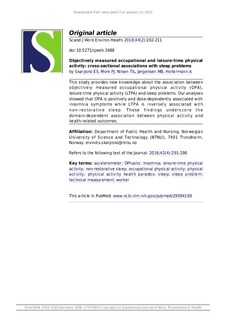Objectively measured occupational and leisure-time physical activity: cross-sectional associations with sleep problems
Skarpsno, Eivind S.; Mork, Paul Jarle; Nilsen, Tom Ivar Lund; Jørgensen, Marie Birk; Holtermann, Andreas
Journal article, Peer reviewed
Published version
Permanent lenke
http://hdl.handle.net/11250/2636139Utgivelsesdato
2018Metadata
Vis full innførselSamlinger
Originalversjon
Scandinavian Journal of Work, Environment and Health. 2018, 44 (2), 202-211. 10.5271/sjweh.3688Sammendrag
Objectives This study aimed to investigate (i) the associations between occupational physical activity (OPA) and leisure-time physical activity (LTPA) with insomnia symptoms and non-restorative sleep and (ii) the joint associations between OPA and LTPA with insomnia symptoms and non-restorative sleep, respectively.
Methods Data were drawn from a cross-sectional study including 650 workers in the Danish PHysical ACTivity cohort with Objective measurements (DPhacto). OPA and LTPA were measured with accelerometers on the thigh and upper back for up to six consecutive days and subsequently divided into quartiles of “very low”, “low”, “medium” and “high” activity. We used logistic regression to calculate odds ratios (OR) with 95% confidence intervals (CI) for insomnia symptoms and non-restorative sleep associated with OPA and LTPA.
Results A 10% increase in OPA was associated with a higher prevalence of insomnia symptoms (OR 1.39, 95% CI 1.03–1.89) but not with the prevalence of non-restorative sleep (OR 0.93, 95% CI 0.71–1.21). On the other hand, a 10% increase in LTPA was associated with a lower prevalence of non-restorative sleep (OR 0.51, 95% CI 0.28–0.92). Although no significant additive interaction was found, analyses of the joint association of OPA and LTPA showed that people with high OPA and low LTPA had an OR of 2.07 (95% CI 1.01–4.24) for insomnia symptoms, compared to those with low OPA and high LTPA, whereas people with high levels of both OPA and LTPA had an OR of 1.47 (95% CI 0.73–2.96).
Conclusions While LTPA was associated with lower prevalence of sleep problems, OPA was associated with higher prevalence of insomnia symptoms. A combination of high OPA and low LTPA were more strongly associated with insomnia symptoms compared to a combination of low OPA and high LTPA.
